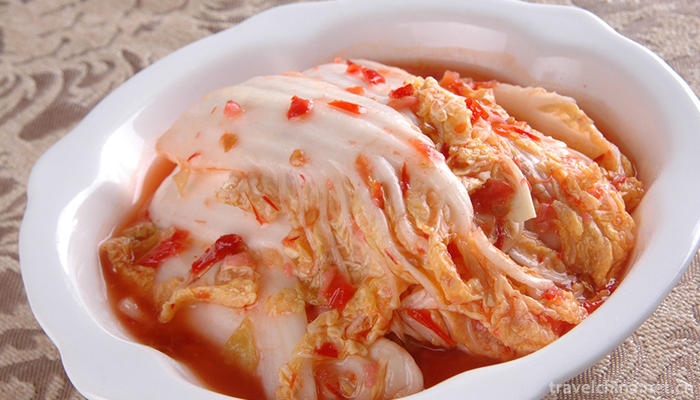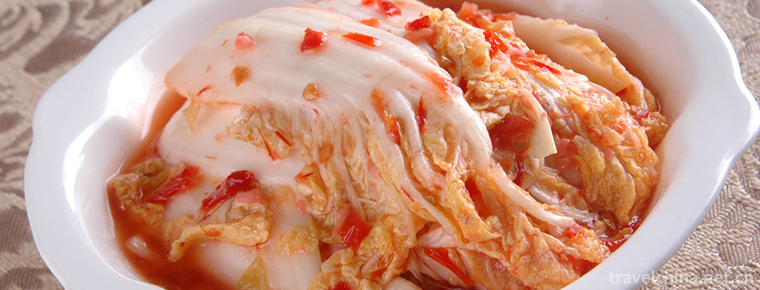Kimchi Making Skills Korean Kimchi Making Skills
Kimchi Making Skills Korean Kimchi Making Skills
Kimchi of Korean nationality is one of the traditional food with the most national characteristics of Korean nationality, and its pickling method is constantly enriched and developed. In the long history, the Korean people in China have absorbed the advantages of other nationalities'diet and made up for their weaknesses. They not only preserved the culinary habits of kimchi from their ancestors, but also created the Korean kimchi culture with Chinese characteristics.
Pickles have a long history of pickling. According to the Book of Songs, pickles made from cucumbers about 3,000 years ago are called "tobacco", which is what modern people call pickles. Ancient pickles were only salted with brine or vinegar. The collection of poems and essays "Dongguo Xiangguo" also recorded the situation of pickled radish pickles. According to the October article of the New Year Records of the Eastern Country written in the mid-19th century, pickling in summer and pickling in winter became the "big plan of a year" for every household. This custom has continued to this day in the Korean countryside of our country. Nowadays, kimchi is not only a necessary storage food for Korean people all year round, but also a favorite side dish.
There are many kinds of pickles. The names and tastes of pickles vary according to the main ingredients and accessories. There are mainly pickled cabbage, vulgar cabbage, pickled mustard, pickled radish, pickled garlic, pickled onion. Pickles with Chinese cabbage as the main ingredient include hot cabbage, hot pepper seed pickles, white pickles and so on, the most common of which is hot cabbage.
Spicy cabbage is a popular food. People can taste its delicious taste almost anytime and anywhere. But spicy cabbage tastes exquisite, but many people do not know. Spicy Chinese cabbage needs to chew slowly, which is not only beneficial to digestion, but more importantly, spicy Chinese cabbage contains a variety of vitamins and acidic substances. Only chewing slowly, these substances can be fully absorbed and utilized.
Hot cabbage, as a traditional Korean diet, is well known in Northeast China. Because of the popularity of Korean Current, China on the Tongue Tip and Yanbian Taste, Korean pickles marked by spicy cabbage are also well known to the whole nation. When I was doing my master's thesis, I had conducted unstructured interviews with some local, foreign and foreign Han people about Korean cultural representation. One of the keywords that almost all respondents would mention was "hot cabbage".
At the end of the 19th century, a large number of Korean ancestors moved into the northeast of China, and their national culture and a wide variety of pickles were introduced. Although the living and living environment in foreign countries has changed dramatically, they still maintain their own cultural traditions and unchanged eating habits for a long time. From the early reclamation to the struggle with the Japanese Emperor, in these hard years, they were never interrupted and encouraged every day, except for one cavity of blood, which was the unchanged kimchi as a concrete manifestation of national culture, and also satisfied the consolation of their own soul. It is precisely the skills of the nation, which are convenient to preserve, cheap, crisp, refreshing, cold-resistant, warm-up traditional diet to accompany and support them through the most difficult times, and continue to "ferment" their deep desire for national liberation and their firm belief in sticking to and inheriting national culture.
As spicy cabbage slowly tastes in the transformation of time, I also gradually "ferment" under the influence of Korean culture. Some anthropologists often try to "turn themselves into local people", but they are still regarded as outsiders, and my anthropologist apprentice may have a little better luck and become a "half Korean" in his classmates'daily jokes. Of course, this not only refers to more than half of my taste buds conquered by Korean cuisine, but also to the fact that Korean culture has been subtly integrated into my personal world.


-
1.Lijiang River
The Lijiang River, a branch of the upper reaches of the Guijiang River
Time 2018-10-12 -
3.Shantou Fangte Happy World Blue Mercury Theme Park
Shantou Fangte Happy World Blue Mercury Theme Park is the first participatory high-tech theme park in eastern Guangdong with science fiction as its theme, integrating entertainment,
Time 2019-02-08 -
4.Scratch sheep race
The Naoyang Competition is a traditional Chinese folk custom activity mainly in Xinzhou City, Shanxi Province. It's a wrestling competition with a live sheep as a prize. In the countryside, "scra
Time 2019-06-07 -
5.Ulger
Uliger, which means "storytelling" in Mongolian, is commonly known as "Mongolian Shushu", "Mongolian Shushu" and "Mongolian Qinshu". It is a form of music art t
Time 2019-06-29 -
6.Production Techniques of Oolong Tea
Oolong tea production technology is a local traditional handicraft in Anxi County, Fujian Province. Historically, during the reign of Yongzheng in Qing Dynasty (1723-1735), tea farmers in Anxi County
Time 2019-06-29 -
7.Xingtai plum blossom boxing
Plum Blossom Boxing is also called Plum Blossom Pile and Plum Blossom Boxing. One of the traditional Chinese martial arts. For the convenience of drilling, drilling on the ground is more extensive, kn
Time 2019-07-08 -
8.The Decorative Techniques of Yi Lacquerware
Yis lacquerware decoration technology chooses high-quality azalea, acid wood, camphor wood as raw materials, through sawing, planer, grinding, sticking and other processes, and then carefully paint th
Time 2019-07-12 -
9.Guo Moruo
Guo Moruo (1892 1978), formerly known as Guo Kaizhen, the word Ding Tang, the warrior, the baby name leopard, the pseudonym of Mo, Michael, Guo Dingtang, Shi Tuo, Gao Ruhong, Yang Yi and so on. Born i
Time 2019-09-07 -
10.Lemon Honey Tea
Honey lemon tea is made of honey and lemon. It has many functions such as whitening, nourishing, lowering blood fat, clearing heat, detoxifying, moistening and drying. Lemon contains vitamin B1, vitam
Time 2020-03-16 -
11.Gufo weir
Located in Huanglongxi section of Jinjiang River in Chengdu, Gufo weir was built in the 25th year of Qianlong reign. Zhangfengzhu, the magistrate of Pengshan County, built a weir to irrigate Huayang, Renshou and Pengshan Sanyi fields.
Time 2020-11-05 -
12.guangan medical and health work
As of 2019, there are 3443 health institutions in Guang'an City. Among them, there are 79 hospitals, 174 health centers, 24 community health service centers (stations), 379 clinics, clinics and clinics, 2 blood collection and supply institutions, 7 matern
Time 2020-12-19